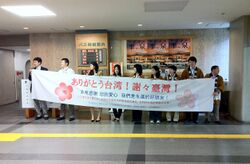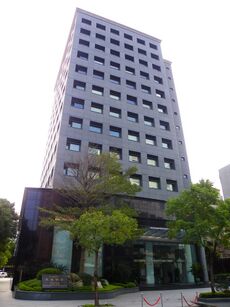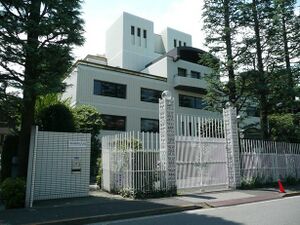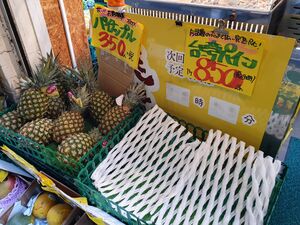العلاقات التايوانية اليابانية
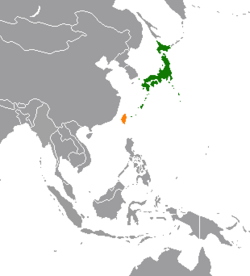 | |
اليابان |
تايوان |
|---|---|
| البعثات الدبلوماسية | |
| جمعية التبادل التايواني الياباني | مكتب التمثيل الاقتصادي والثقافي لتايپـِيْ في اليابان |
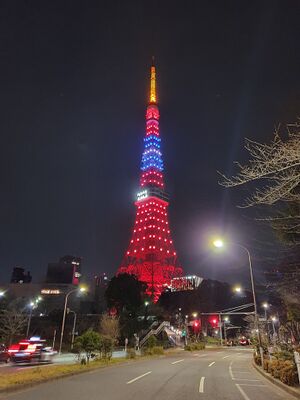
After the Japan–PRC Joint Communiqué in 1972, Japan no longer recognizes the Republic of China as the sole official government of China. However, Japan has maintained non-governmental, working-level relations with Taiwan.[1]
التاريخ
التاريخ المبكر
In the 1600s, there was considerable trade between Japan and Taiwan. The Dutch colonized Taiwan as a base for trade with Japan in 1624.
مملكة تونگننگ وتايوان تحت حكم تشينگ
During the Kingdom of Tungning era (1662–83), Japan bought deerskin, sugar and silk from Taiwan and sold precious metal, porcelain, armors and cotton cloth. Japanese money could be used in Taiwan during that period and Japanese merchants were permitted to live in Keelung.[2][3][4]
In 1874, Japanese troops invaded southern Taiwan to attack aboriginal tribes, in revenge for the killing of 54 Ryukyuan sailors in 1871.
تايوان تحت الحكم الياباني
Japan's victory over Qing dynasty in the First Sino-Japanese War resulted in the 1895 Treaty of Shimonoseki, in which Taiwan was ceded to Japan. Taiwan was then ruled by the Empire of Japan until 1945. After Japan's surrender at the end of World War II, Taiwan was placed under the governance of the Republic of China.
جمهورية الصين في تايوان
التأسيس المبكر، أوائل الخمسينيات
After the war between China and Japan, during the occupation of Japan, Prime Minister Shigeru Yoshida (officially the last prime minister under the royal decree by the Japanese emperor), intended to approach the newly established People's Republic of China economically and diplomatically. However, the US rectified this initiative and threatened to boycott the 1951 Treaty of San Francisco if Japan did not engage with KMT-led Nationalist China (now Taiwan) and the later formation of the Treaty of Taipei (a parallel treaty to the Treaty of San Francisco between Japan and the two Chinas that were excluded). The US required Japan to accept diplomatic relations with the KMT-led Nationalist China; otherwise, sovereignty to the country would not be restored, effectively maintaining war with the US and keeping it under US military occupation.
By taking everything into consideration, in the midst of the US creating its containment policy in Asia, Prime Minister Yoshida shifted his stance with regard to the US administration (to then-US Secretary of State John Foster Dulles), as detailed in the Yoshida Letter,[5] to negotiate a peace treaty with Taipei instead. Also as a result of ratification of the Treaty of San Francisco by the US Congress and Senate, he officially ended Japan's status as an imperial power, officially relinquishing of the island of Taiwan and Pescadores. These actions were drafted into Article 9 of the new liberal democratic Japanese Constitution which dismantled the country's military capabilities to declare war on another country with the reservation of self-defense limitations and later stipulated the Security Treaty Between the United States and Japan, which was also passed and enacted by the majority members of the new Japanese Diet with subsequent security treaties in the post-war era.
With the eruption of the Korean War and US and UN intervention in that war, diplomatic relations between the governments of Japan and KMT-led Nationalist China were established following the termination of US occupation of Japan in 1952. Japan led the logistics and artillery production/manufacturing industry to support the US in the Korean War, which acted as the major stimulus for the revival of its economy, especially in heavy and light industry, soon evident in the Japanese post-war economic miracle. On April 28, 1952, a formal peace treaty was concluded between the Japan and what is now Taiwan, as the former refrained from recognizing the People's Republic of China at that time. In Article 10 of the Treaty of Taipei (Sino-Japanese Peace Treaty) that retrospects:[مطلوب توضيح]
for the purposes of the present Treaty, nationals of the Republic of China shall be deemed to include all the inhabitants and former inhabitants of (Taiwan (Formosa)) and Penghu (the Pescadores) and their descendants who are of Chinese nationality in accordance with the laws and regulations which have been or may hereafter be enforced by the Republic of China in Taiwan (Formosa) and Penghu (the Pescadores); and juridical persons of the Republic of China shall be deemed to include all those registered under the laws and regulations which have been or may hereafter be enforced by the Republic of China in Taiwan (Formosa) and Penghu (the Pescadores).
Bilaterally, Japan had, and still has from members of the Japan Business Federation, strong trading ties with Taipei. Japan played a key financial role of governmental loans to the ROC government to help with the burgeoning country's economic development on various levels before the Nixon Shock[6][7][8] and the severing of ties between the two governments.
In 1958, the Sino-Ryukyuan Economic and Cultural Association was established at Naha, Okinawa, which was the strategic headquarters of the US Armed Forces in the region. In 1972, Okinawa was returned to Japan by the U.S., but the association remained as an institution to foster relations, dialogue and academic exchange between Japan, Okinawa and Taiwan.
البيان المشترك، 1972
Regarding the One-China policy, Japan had been an earnest ally to Taiwan, however, global politics pushed Japan to overturn its position. As the attempt to belligerently recover mainland China failed and faded and the Taipei-based government was expelled, voted out of UN in a General Assembly vote, by majority UN member states via United Nations General Assembly Resolution 2758, soon after US President Richard Nixon's visit to People's Republic of China in 1972[9] and the release of the "Joint Communiqué of the United States of America and the People's Republic of China," Japan's Liberal Democratic Party-majority government led by Kakuei Tanaka decided to establish formal diplomatic relations with the PRC. Before this, Japan had already had robust non-governmental trading relations with the PRC without formal diplomatic recognition.
As a pre-condition for building ties with the PRC, Japan abrogated and made defunct the Treaty of Taipei in relation to then non-recognized Taiwan polity. According to the "1972 Japan–China Joint Communiqué", the Japanese government fully understood and respected the position of the government of the People's Republic of China (PRC) that Taiwan was an inalienable territory of the PRC, and it firmly maintained its stand under Article 8 of the Potsdam Proclamation,[10] which stated "The terms of the Cairo Declaration shall be carried out and Japanese sovereignty shall be limited to the islands of Honshū, Hokkaidō, Kyūshū, Shikoku and such minor islands as we determine."
Statements and principles set in the Joint Communiqué of 1972 were written in the Treaty of Peace and Friendship between Japan and the People's Republic of China in 1978. Japan and the PRC agreed to continue abiding by the treaty when former Prime Minister of Japan Shinzo Abe visited Beijing on 8 October 2006.
البيان الصيني-الياباني المشترك، 1998
In 1998, Japan and the PRC signed the Japan–China Joint Declaration on Building a Partnership of Friendship and Cooperation for Peace and Development that stated that Japan was to continue to side with the PRC on the One-China policy, that it "continues to maintain its stand on the Taiwan issue as set forth in the Joint Communiqué of the Government of Japan and the Government of the People's Republic of China and reiterates its understanding that there is only one China." Japan reiterated it will maintain its exchanges with Taiwan, however in a private and regional forms.
المبادرات الأخيرة، 2005–الحاضر
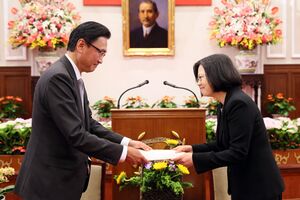
Japan grants Taiwanese passport holders visa exemption for 90 days.[11] This rule became effective on 20 September 2005, in line with a move aimed at attracting more tourists to Japan. Jiro Akama, Deputy Minister of Internal Affairs and Communication was the highest ranking cabinet official since 1972 to visit Taiwan on March 25 to celebrate the tourist event and promote Japanese regional revitalization,[12] amid with the ban of Japanese agricultural exports to Taiwanese public.[13]
In the press conference on 31 January 2006, Deputy Press Secretary Tomohiko Taniguchi announced that, in a speech a year earlier, Minister of Foreign Affairs Tarō Asō had expressed concern regarding peace and stability across the Taiwan Strait on the basis of the 1972 Japan–PRC Joint Communiqué. The announcement reiterated the Japanese government's position "that we do not take a policy of two Chinas or one China and one Taiwan."
In 2020 Japan received donations of equipment and supplies as part of Taiwan's medical diplomacy in response to the COVID-19 epidemic. More than 2 million face masks were delivered in mid April 2020.[14]
As the People's Republic of China banned Taiwan pineapples, the Japanese representative office in Taipei expressed support for Taiwanese pineapple consumption,[15] and Taiwan pineapples became a hot commodity in Japan.[16]
Japan has been drawing closer to Taiwan as a result of their concerns over Beijing’s economic and military power. In 2021 Japan’s annual military white paper explicitly mentioned Taiwan for the first time.[17]
In September 2021, Taiwan donated 10000 pulse oximeters and 1008 oxygen concentrators to Japan[18][19] Japan Prime Minister Yoshihide Suga thanked Taiwan for the medical equipment, including a "Thank you Taiwan" written in Taiwan's traditional Chinese characters, and adding that Japan and Taiwan have cultivated their friendship by helping each other in times of natural disasters and pandemics.[20][21]
في 17 ديسمبر 2021، أعلنت وزارة الخارجية اليابانية أن المنصب الجديد، الذي سيبدأ العمل في أبريل المقبل، يختص بالقضايا البحرية في بحر الصين الشرقي، بما في ذلك تايوان وجزر سنكاكو. وقالت المشرعة ماساهيسا ساتو بعد الكشف عن الخطة: "هذه خطوة عظيمة نحو الأمام".
تعتبر بكين تايوان مقاطعة انفصالية تنتظر إعادة التوحيد، ولديها نزاع إقليمي مع اليابان حول جزر سنكاكو، التي تدعي أنها جزر دياويو.
وأشار ساتو إلى أن تحرك طوكيو يأتي في وقت تتصاعد فيه التوترات بين تايبيه وبكين، حتى في الوقت الذي تعمل فيه اليابان عن كثب مع الأولى في الشئون الأمنية والخارجية والاقتصادية. وقالت الوزارة إن كبير الدبلوماسين الياباني سيراقب عن كثب الوضع في مضيق تايوان ويسهل التبادلات بين كبار المسئولين التايوانيين ونظرائهم الأوروبيين والأمريكيين.
ليس هناك علاقات دبلوماسية رسمية بين طوكيو وتايبيه - حيث تعترف ببكين باعتبارها الحكومة الشرعية الوحيدة للصين - ولكنها تحافظ على علاقات غير حكومية وعلى مستوى العمل مع حكومة الجزيرة. ومع ذلك، فمن غير المعتاد تخصيص منصب دبلوماسي ياباني باسم تايوان.
وتأتي هذه الخطوة أيضًا في وقت تزايدت فيه حدة التوتر بين بكين وطوكيو في الأشهر الأخيرة بشأن تايوان، خاصة بشأن تصريحات رئيس الوزراء الياباني السابق شينزو آبه. بعد أن قال في وقت سابق من هذا الشهر إن اليابان والولايات المتحدة لا يمكنهما الوقوف مكتوفي الأيدي في حال تعرض تايوان لهجوم، حذر آبي قبل ثلاثة أيام بكين من أن أي هجوم عسكري على تايوان سيكون "انتحاريًا".
وهددت بكين بإعادة النظر في العلاقات الثنائية مع اليابان بعد تصريحاته السابقة، واستدعت السفير الياباني هيديو تارومي لعقد اجتماع طارئ. وقال هوا تشون ينگ، مساعد وزير الخارجية الصيني، إن تصريحات آبي "تحدٍ علاني لسيادة الصين وقدمت دعمًا قويًا لقوى استقلال تايوان".
ومن المتوقع أن يتعامل كبير الدبلوماسيين الجديد مع القضايا ليس فقط المتعلقة بتايوان ، ولكن دياويوس، وهي مجموعة من الجزر غير المأهولة في بحر الصين الشرقي والتي تدعي بكين السيادة عليها. تسميهم اليابان سنكاكو وتطالب بمطالبة منافسة.
ويقول ليان ديگي، أستاذ ومدير مركز الدراسات اليابانية في جامعة شانغهاي للدراسات الدولية أن "إنشاء مثل هذا المنصب سيزيد من تدهور العلاقات الصينية اليابانية، خاصة بعد التعليق الأخير الذي أدلى به آبي." وأشار ليان إلى أن اليابان تتدرب على كيفية الرد على تايوان إذا كانت هناك أزمة في مضيق تايوان. وقال، بما أن واشنطن تعمل بنشاط على تضخيم قضية تايوان، فإن اليابان تحذو حذوها.
وفيما يتعلق بكيفية رد فعل بكين على هذه الخطوة، قال ليان إن من السابق لأوانه التنبؤ. "فقط عندما يعلن وزير الخارجية عن المنصب الجديد ويتم إنشاؤه رسميًا (سنكون قادرين) على رؤية رد فعل بكين".[22]
ترسيم مصايد الأسماك، 1996–الحاضر
دعوى مسكن الطلبة گوانگ هوا لياو (كوكاريو)
الاستجابة لزلزال توهوكو 2011
لقاحات كوڤيد-19
In the context of the COVID-19 pandemic, Japan sent 1.24 million doses of vaccine to Taiwan for free on 4 June 2021.[23][24] This prompted a wave of gratitude from Taiwanese people,[25] while the Chinese Communist Party condemned Japan's move.[26] This was followed by 5 other shipments over 2021, totaling 4.2 million doses, with the Japanese Ministry of Foreign Affairs saying it is an expression of warm friendship and good will.[27]
التعليم
Japan operates three nihonjin gakkō (overseas Japanese schools operated by a Japanese association) on the island of Taiwan:
الثقافة
On 21 April 2010, Taiwan established the Taipei Cultural Center in Tokyo, Japan and was subsequently renamed Taiwan Cultural Center. On 27 November 2017, Japan established the Japanese Cultural Center in Taipei, Taiwan.
انظر أيضاً
- العلاقات الصينية اليابانية
- مكتب التمثيل الاقتصادي والثقافي لتايپـِيْ في اليابان
- رابطة علاقات شرق آسيا
المصادر
- ^ "Recent Japan-Taiwan Relations and the Taiwan Situation" (PDF). First and Second China and Mongolia Divisions, Asian and Oceanian Affairs Bureau, Ministry of Foreign Affairs. July 2013.
- ^ 《台灣史101問》,頁109
- ^ 《臺灣政治史》,頁62-63
- ^ "鄭氏時期總論". Archived from the original on 2013-06-29. Retrieved 2014-04-30.
- ^ Cohen, J p. 50-56, Iriye, A. Cohen, W p. 21-34, Schonberger, H p. 275-285
- ^ "international payment and exchange - economics". Encyclopædia Britannica. Retrieved 3 April 2016.
- ^ "About the IMF: History: The end of the Bretton Woods System (1972–81)". Retrieved 3 April 2016.
- ^ ERIC RAUCHWAY (13 November 2015). "Bretton Woods System". Retrieved 3 April 2016.
- ^ "Nixon announces visit to communist China". HISTORY.com. Retrieved 3 April 2016.
- ^ Joint Communique of the Government of Japan and the Government of the People's Republic of China "3. The Government of the People's Republic of China reiterates that Taiwan is an inalienable part of the territory of the People's Republic of China. The Government of Japan fully understands and respects this stand of the Government of the People's Republic of China, and it firmly maintains its stand under Article 8 of the Postsdam Proclamation."
- ^ As the residents in Taiwan were stipulated by a government ordinance as aliens defined in the Law on Special Cases of Landing Application by Aliens who hold passports stipulated in Article 2-5-2 of the Immigration Control and Refugee Recognition Act
- ^ "Japan vice minister officially visits Taiwan".
- ^ "《TAIPEI TIMES 焦點》 High-level Japanese official visits - 焦點 - 自由時報電子報". 2017-03-25.
- ^ "Japan receives 2 million face masks donated by Taiwan to combat COVID-19". The Japan Times Online. Japan Times. 21 April 2020. Retrieved 22 April 2020.
- ^ https://www3.nhk.or.jp/nhkworld/en/news/20210317_19/
- ^ "Japanese help Taiwan run rings round pineapple ban".
- ^ Penn, Michael. "The politics of Japan's Taiwan vaccine donation". www.aljazeera.com. Al Jazeera. Retrieved 11 June 2021.
- ^ https://www.mofa.gov.tw/News_Content.aspx?n=95&sms=73&s=96491
- ^ https://www.facebook.com/mofa.gov.tw/posts/1150431778814796
- ^ @sugawitter (16 September 2021). "台湾の皆さまへ台湾から日本への酸素濃縮器と血中酸素濃度計の供与に心から御礼申し上げます。日本と台湾は自然災害や感染症の脅威に向き合うたび、人道的見地から互いに助け合うことで友情を育んできました。台湾から頂く機材は、これらを必要…" (Tweet) – via Twitter.
{{cite web}}: Cite has empty unknown parameter:|dead-url=(help) - ^ https://news.yahoo.co.jp/articles/b9f82f303f872e2196acdb0cae8373d0f2d96d8b
- ^ "Japan creates new post to handle Taiwan affairs, as tensions rise with Beijing". scmp. 2021-12-17. Retrieved 2021-12-17.
- ^ "Taiwan, feuding with China, gets vaccines from Japan". 4 June 2021.
- ^ "Taiwan's COVID-19 vaccine stocks more than doubled by Japan donation". Reuters. 2021-06-04. Retrieved 2021-06-10.
- ^ "'Thank you, Japan Airlines': Taiwan air traffic controller commends flight for bringing in vaccines |Appledaily". Apple Daily (in الإنجليزية الأمريكية). Retrieved 2021-06-10.
- ^ "China condemns Japan offering vaccine to Taiwan | NHK WORLD-JAPAN News". NHK WORLD (in الإنجليزية). Retrieved 2021-06-10.
- ^ https://news.yahoo.co.jp/articles/61dc7c5ec29fb1a223d5a7d615999a3ef5ed9aea
قراءات إضافية
| مراجع مكتبية عن العلاقات التايوانية اليابانية |
- Cohen, J 1973 The Dynamics of China's Foreign Relations, p. 50-56, Harvard University Press, Cambridge
- Dreyer, June Teufel. "The Japan-Taiwan Relationship: An Unstable Stability." Asia Policy 26.1 (2019): 161–166. online
- Iriye, A. and Cohen, W 1989 The United States and Japan in the Postwar World, p. 21-34, The University Press of Kentucky
- Hu, S. ‘Japan and the Cross-Taiwan Strait Conflict,’ Journal of Chinese Political Science, Vol. 11, No. 2 (Fall 2006): pp. 83–103.
- Schonberger, H 1989 Aftermath of War - Americans and the Remaking of Japan, 1945–1952, p. 275-285, The Kent State University Press,
- Wilkins, Thomas, "Taiwan-Japan Relations in an Era of Uncertainty" Asia Policy, Vol. 13, (January 2012), pp. 113–132.
